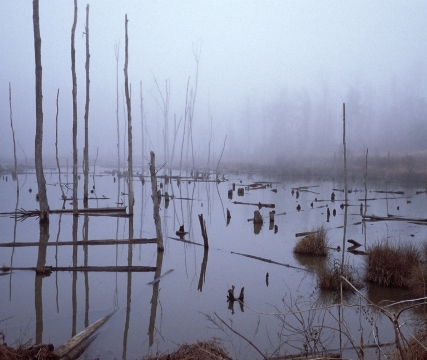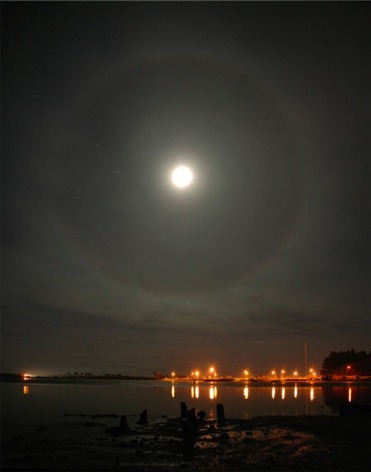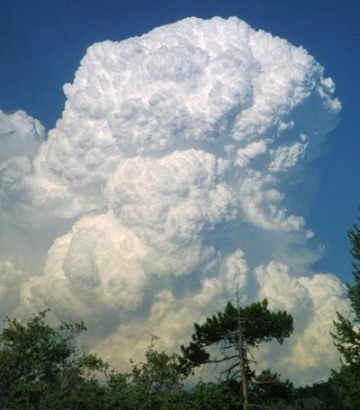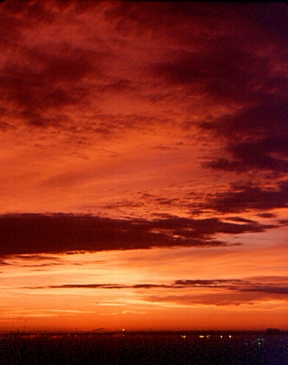Before we had the ability to "tune-in" the local weather report, our ancestors depended on observations and patterns in nature to predict changing weather conditions. Many of these were incorporated into folk lore that has been passed thru time.
Just as modern technology is not totally accurate to forcast weather conditions these methods are not guarnteed either, but they can be still used to assist in monitoring changing weather conditions.
As a general rule pressure typically falls before bad weather, and rising pressure indicates improving weather
Predicting Weather Using Signs Of Air Pressure

"Chimney smoke descends, our nice weather ends." Smoke from a fire curling towards the ground instead of rising is also a sign of low pressure.
"It smells like rain." Another sign of low pressure is decaying vegetation in soil, pond and marshes. Gases form which, under normal pressure stay put. Low pressure allows pockets of these gases to escape, giving the air an "earthy" smell or, near stagnant water, something less pleasant.
A counter clockwise shift in wind direction indicates a low pressure system is moving in. A shift from north to west, for example, is a sign of rain because that's the direction air moves around a low pressure system.
As the pressure decreases, the dust particles in the air begin to settle to the ground and the air clears. Sound becomes sharper and things will smell stronger. That's why you think the air is clean and fresh and bird songs and calls sound sharper before a rain.
High Humidity Signs
"Halo around the sun or moon, rain or snow soon." The halo around the sun or moon is a layer of cirrus clouds made of ice crystals. These ice crystals act as tiny prisms, forming a white or sometimes colorful halo around the sun or moon. This cirro-stratus cloud often indicates an approaching warm front and an associated area of low pressure. Rain or snow will not always follow, but there is a higher probability of it after a halo is seen, and the brighter the circle, the greater the probability.
When pitcher plants open, humidity is high and rain threatens. Wildflowers like daisies and chickweed close up when the relative humidity near the ground reaches 82%, another rain sign.
When leaves show their undersides, be very sure that rain betides.
Frogs provide storm warnings when they emerge from the water and start croaking as humidity rises.
About 12 hours before a storm hits, insects fly lower than usual and seem to swarm more because, when the upper air holds a lot of moisture, it condenses on their wings and hairs and makes flying difficult. Two hours before the storm, they stop flying altogether.
A night filled with fireflies is other signs of moist air.
When grass is dry at morning light. Look for rain before the night.
Grasshoppers won't give you a precise temperature reading but, If they are singing, It's above 84 degrees F. Count cricket chirps for 14 seconds and add 40 to come up with the temperature in fahrenheit. If the crickets quit chirping, they're saying it's either above 105 degrees F or below 40 degrees F.

Signs Of Nice Weather

When the fog in morning disappears in the 2 hours after sunrise
Dew on the grass, rain won't come to pass. Dew forms when the ground loses heat quickly, and that only happens when the air above is dry.
When the moon is brilliant and its edges are sharp.
When the sun is a red ball at sunset
A rainbow in the morning, is the shepherd's warning. A rainbow at night is the shepherd's delight.
Animal Observations
Animals are far more likely to react to changes in air pressure than we are.
Animals, especially birds, get very quiet immediately before it rains.
Cows will typically lie down before a thunderstorm. They also tend to stay close together if bad weather's on the way.
If birds are flying high in the sky, there will probably be fair weather. (Falling air pressure caused by an imminent storm causes discomfort in birds' ears, so they fly low to alleviate it.) Bats also can be observed flying lower
Large numbers of birds roosting on power lines indicates swiftly falling air pressure.
A drop in air pressure sets wolves howling because it hurts their ears. You'll often see crows and robins walking. Ants tend to scurry about and spiders busily repair their webs before a storm, but it's not clear if they are responding to low pressure or high humidity.

Clouds

Clouds going in different directions (e.g. one layer going west, another layer going north) - bad weather coming, probably hail
Cumulonimbus clouds early in the day and developing throughout the day - greater chances of severe weather
Mammatus cloud (formed by sinking air) - thunderstorm is dissipating (not forming)
Cirrus fibratus, (aka "mare's tail" ) Cirrus clouds high in the sky like long streamers - bad weather within the next 36 hours
Altocumulus mackerel sky Altocumulus clouds like mackerel scales - bad weather within the next 36 hours. The old sailor's saying for these types of clouds is "Mares tails and mackerel scales, tall ships carry short sails." Mackerel skies and mares tails formations sometimes appear in the same sky. When that happens, rain is sure to follow the next day.
Cumulus towers (cumulus castellanus) - possibility of showers later in the day
Red Sky
"Red sky at night, sailors delight, Red sky at morning, sailors take warning"
When the western sky is especially clear, there is often a red sunset. That's because as the sun sets, its light shines through much more of the lower atmosphere, which contains dust, salt, smoke and pollution. These particles scatter away some of the shorter wavelengths of light (the violets and blues), leaving only the longer wavelengths (the oranges and reds.) If an area of high air pressure is present, the air sinks. This sinking air holds air contaminants near the earth, making the sunset even redder than usual. This would be the "red sky at night."In the middle latitudes of the northern hemisphere, weather systems most often approach from the west. Since high pressure generally brings fair weather, this type of red sky at sunset would indicate that clear weather is approaching, which would "delight" a sailor. If the sky is red in the eastern morning sky for the same reasons as above, then the high pressure region has most likely already passed from west to the east, and an area of low pressure may follow. Low pressure usually brings clouds, rain or storms, a warning for sailors.
Don't confuse a red sky in the morning with a red sun in the morning. If the sun itself is red and the sky is a normal color, the day will be fair.

